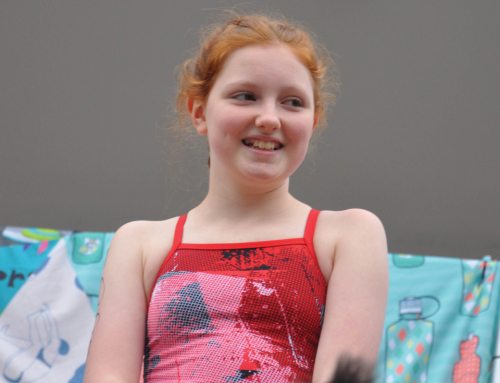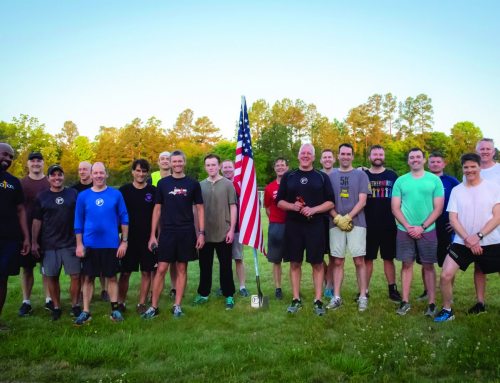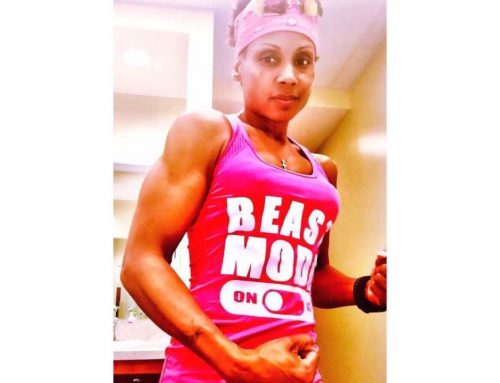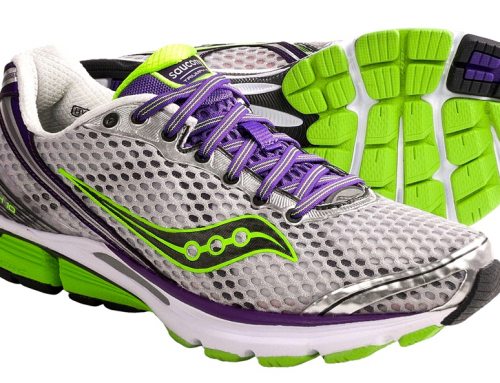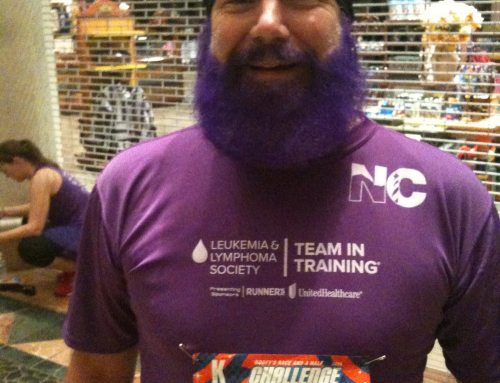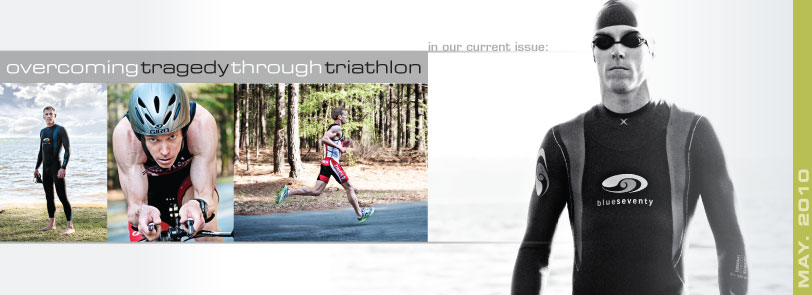
By Joe Nuss
As an elite runner, Tim Surface’s 2:24 marathon at the Chicago Marathon in 2006 was a disappointment. Not only had a 2:18 finish eluded him in his debut marathon, so had his secondary 2:22 goal as well. Too competitive to give up, Tim quickly regrouped and set his focus on the Houston Marathon a few months later. But, a disappointing half marathon in December of that year left him flat. Running used to be fun, but according to the elite runner, he was no longer sure why he was running. Was it for himself? Was it for all the people who expected him to do it? Whatever it was, it was no longer fun and the new father decided to take a break from running and focus on his family and career.
His athletic interests were revived, however, after receiving a call from his good friends in Missouri. While Tim had always pursued running, his friends Kevin Hunt and Ryan Moeller had recently taken up cycling and soon started thinking about triathlon. Kevin and Ryan wanted to get Tim in on the fun, too. So, rather than their typical get-together, like their trip to the Grand Canyon, this year the trio decided to tackle a half iron distance triathlon. With Kevin and Ryan training together in Missouri, Tim began training for his first triathlon in Raleigh. After a short season of sprints, they would all meet up for their season-finale half iron event.
But for someone like Tim without a lot of experience swimming, training posed some new challenges.
“I had no idea what I was doing,” confessed Tim. “In running, the harder you work, the faster you go, but I soon found that ‘runner’s mentality’ didn’t apply to swimming. Flailing my arms and legs a lot wasn’t much help in breaking two minutes for 100 yards. It took everything I had just to do that.”
In addition, Tim was still waiting for Ryan to ship his old bike to him. Once he received Ryan’s old Softride, he would really kick his training in gear, he thought. In the meantime, he trained for his first sprint triathlon, the Triangle Triathlon, primarily by running and seeking that breakthrough workout that signaled his return to his elite running form.
But, Tim will never forget the day that breakthrough happened.
“I was so excited,” says Tim, “I couldn’t wait to call Kevin and Ryan. I couldn’t wait to hear how their race had been and share my great workout. That was the great thing about us, we were always there to support each other throughout our training.”
So, sitting in his office at home, Tim called Ryan to hear about the race. But, Ryan’s words left Tim speechless: Kevin is being airlifted to the hospital.
In Kevin’s first race, somewhere short of the swim finish, he went under, and had to be pulled from the water. Not knowing exactly what happened, only that his friend’s life was in jeopardy, Tim Surface fell to his knees in his office and prayed. Then, he bought a plane ticket to Missouri. But, when he arrived, Ryan broke the news to Tim. Kevin was dead. In pursuit of their annual get together, one of the three childhood friends had died. Something intended to be fun and fulfilling had ended in tragedy.
Tim and Ryan were devastated. For Ryan, Kevin’s death meant the end of his pursuit of triathlon. For Tim, the sport was the furthest thing from his mind. Even when Tim returned home after the funeral, he doubted the sensibility of doing an open water swim with his skills. But, then Ryan’s old bike arrived. Shipped before Kevin’s death, the Softride bike was a link to happier times and was now the impetus for not giving up. Tim decided to not let Kevin’s death deter him and signed up for a new race, Mission Man, which included a 750-yard open water swim.
When race day finally arrived and Tim found himself in the water ready to start, race day energy and his competitive spirit took over. Sprinting as fast as he could, unable to abandon his runner’s mentality of working harder, Tim flailed his arms and legs in a mad attempt to win the race from the very start.
“I probably didn’t even make it 200 yards before I was completely gassed,” said Tim. “I started wondering ‘what the hell am I doing’.”
But then he collected himself, convinced himself that he didn’t have to win the race on the swim, stayed calm, and focused on relaxing and simply finishing the swim.
“I ended up going really easy for the rest of the swim,” said Tim. “When I got out of the water and got on the bike, that’s when things turned around for me. I was passing so many people I couldn’t even get to the right of the lane and I thought, ‘Man! This is fun!’ And then before I knew it, I was jumping off the bike en route to a 16:32 5K.”
Tim’s time in the 5K portion of the race tied for the fastest of the day and helped him post a 15th place finish overall in his first ever triathlon. Overcoming his fears in the water also boosted his confidence. For the most part, it was fun, but unbeknownst to Tim, his racing heart rate during the swim wasn’t just fear, it was a more serious condition.
In the coming months, Tim blazed through another local race and in only his third race, the extremely competitive Duke Half Iron, finished 19th overall, despite having the slowest swim time of the top 54 athletes. But again, the racing heart rate was there. When Tim started working with coach and pro triathlete Justin Park, he was encouraged to start training with a heart rate monitor, something pretty standard for serious triathletes.
That’s when Tim started noticing incredible spikes in his heart rate. Remembering Mission Man and a few other race experiences led Tim to seek medical advice. Eventually, fitted with a special device called a Holter monitor, Tim recorded his heart rate, which allowed the doctors to discover that he suffered from atrioventricular nodal reentrant tachycardia, a condition which causes sudden development of rapid regular palpitations, a potentially serious condition. After consulting with his doctors, Tim was scheduled for surgery at Medical University of South Carolina to correct the problem.
Fortunately, his recovery was quick and Tim was back competing in races in a short period of time. With the help of his coach and local retailer Raleigh Running Outfitters, Tim was having fun racing, but he still missed the head-to-head competition he got from running.
“The unique thing about triathlon as an age grouper is that while you can see everyone’s age on their leg, you never quite know what position you’re in,” says Tim. “But, for a naturally competitive person like me, I want to know.”
At Tim’s next big race, Michigan’s Whirlpool Steelhead 70.3 triathlon in 2009, he posted a blazing 4:12:00 finish. More impressive, however, was Tim’s 1:16:16 half marathon – the second fastest run split of all athletes, pros and amateurs. His run time was only two seconds shy of the fastest split by professional Andy Potts who started earlier with the pros.
Despite a 32:05 swim split, which didn’t even crack the top 50 swim times, Tim still finished 11th overall, and more importantly, finished as the top amateur of the day, a feat that earned him his pro ticket.
Now working with local coach and swim expert Dave Williams of Triangle Multisport, Tim hopes to bring his swim time down dramatically as he prepares for his first season as a pro.
“For me, it’s all about head-to-head competition I get as a pro,” he says. “I want to know who I’m racing against and have that spirit of competition pushing me to the next level.”
With a sponsorship from Timex, Tim is getting the help he needs to prepare for his next big race, and first as a pro – Ironman St. George. While Tim actually qualified for Kona as an amateur at Louisville, he’s hoping to use that spirit of competition to earn his first trip to Kona as a pro.


